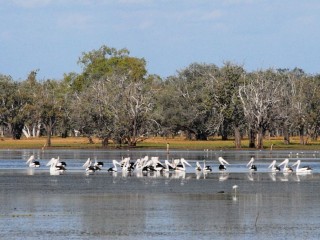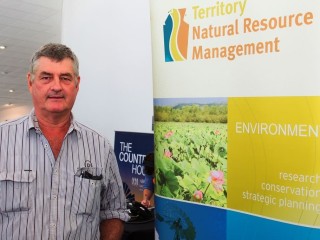 A Top End pastoralist is saving money while protecting natural resources on his cattle station south west of Katherine.
A Top End pastoralist is saving money while protecting natural resources on his cattle station south west of Katherine.
Lakefield Station owners Garry and Michelle Riggs have signed a Territory Conservation Agreement with Territory Natural Resource Management (TNRM) to help protect and manage their land, soil, water, plants and animal in their conservation areas.
Mr Riggs said that after working to reduce the impact of cattle and control the existing water resources on their Sturt Plateau property, he has saved at least $100,000 in one season.
He said that by controlling the water source more efficiently, he can provide water to five paddocks instead of one that would previously have relied on access to the wetlands. As a result he is able to run more cattle on the property.
He has also been able to use a water soluble supplement to grow his cattle rather than a dry supplement, which can be given to cattle through the water supply every six weeks instead of one week. He said this alone had saved him $100,000 in the cost of supplements.
The Riggs fenced off 300 hectares of Flying Fox wetlands on their property last year to reduce the impact of cattle and to protect the water supply for the local wildlife and as a future water source.
They also use three night vision cameras to identify and monitor which animals and wildlife are on their property.
 The Riggs are among 10 rural landholders to have signed Territory Conservation Agreements (TCA) with Territory Natural Resource Management (NRM) to help protect and manage their land, soil, water, plants and animals, including landowners in Darwin’s rural area.
The Riggs are among 10 rural landholders to have signed Territory Conservation Agreements (TCA) with Territory Natural Resource Management (NRM) to help protect and manage their land, soil, water, plants and animals, including landowners in Darwin’s rural area.
Under the TCA, the Riggs were eligible to apply for $48,000 funding to put towards the total cost of $120,000 for the cost of machinery and labour to prepare the area and fence off the Flying Fox wetlands.
Territory NRM is about to sign its 10th Territory Conservation Agreement which is designed to help rural landholders protect areas of high conservation significance on their property.
Since the first TCA was signed in September 2011, more than 1200 hectares of land, including pastoral properties and groups of blocks in Darwin River, are protected under these agreements. Some of the high conservation value sites include wetlands and swamps.
The 10-year agreements are voluntary and worked out between the landholders and
Territory NRM to include:
- site conservation planning,
- grazing and fire management,
- weed eradication,
- soil erosion and stabilisation,
- revegetation, and
- water resources and quality.
The Riggs’ story was one of many that was shared at the Territory NRM Annual Forum in Darwin last Thursday, November 29.
The free forum saw people involved in natural resource management from all over the Northern Territory come together to share their stories, achievements and challenges. The forum topics covered a range of natural resource management issues such as fire management, weed management, feral animal control and protecting sites and species.
The Territory NRM provides expertise, advice and funding through the Australian Government’s Caring for Country funding to help natural resource management projects across the Top End, through the Gulf, Barkly and Katherine regions and Central Australia.
Over the past year it has funded 37 groups including 13 Indigenous land management groups, four pastoral landcare groups, eight pastoralists, four educational institutions, four conservation organisations, three urban land care groups and four local government and industry groups.
Facts and figures on Territory NRM
- Territory Natural Resource Management supported the management of more than 139,430 hectares to reduce the impact of weeds
- 600 individual land holders have developed management plans and implemented gamba grass control on their properties in the NT
- Feral control projects involved 24 land managers covering 94 3000 hectares were set up in 2011-12 targeting seven types of vertebrate pests including donkeys, horses, buffalo, foxes, cats, pigs and rabbits
- Since the first Territory Conservation Agreement was signed in September 2011, more than 1200 hectares of land (including pastoral properties and rural block owners) are protected under these agreements
- The 10th Territory Conservation Agreement is about to be signed by land holders in the Daly River catchment
- Territory Natural Resource Management has continued work with and support four pastoral landcare groups across the Territory with a second round of Local Grants sharing more than $210 000 to undertake natural resource management activities to improve the land on their properties.
Source: Territory NRM
